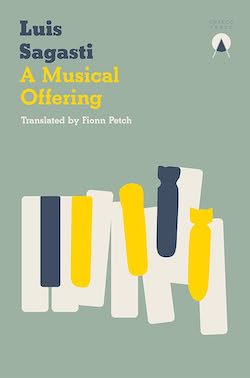Translated from Spanish by Fionn Petch
Published by Charco Press, 2020, 111 pages. Original version published in 2017.
“But have we not heard this in countless songs that begin all over again after a refrain? Or when the volume gradually fades, giving the impression that the band is disappearing into the distance and the song is actually endless?”
This is an ode to music that reads like a symphony. Themes appear, disappear and reappear a few chapters later. Luis Sagasti takes us on a journey through history and time, ending where he begins, with Bach’s Goldberg Variations.
We learn about Count Keyserling in the 18th century, who has severe insomnia. To help him sleep, he commissions the cantor of St. Thomas of Leipzig—Johann Sebastian Bach—to write him a piece of music that will put him to sleep. Bach writes an aria with 30 variations. Each evening Johann Gottlieb Goldberg, a talented harpsichordist, goes to the Count’s home and plays the music outside his chamber until the Count falls asleep. To honour this performance, the piece becomes known as the Goldberg Variations.
In contemporary times, the Goldberg Variations have been made famous by Glenn Gould, who also suffered from insomnia. Gould recorded the Variations twice: first in 1955 when he started out as a classical pianist and then again in 1981 towards the end of his career. The two versions differ—the first is a young man’s piece, urgent and flamboyant, and the second is an older man’s version, slower, “that of someone who knows we only leave a circle before taking the first step”.
Music is not only about sounds, though. Silence is also a form of music. John Cage’s work, 4’33” is silent. A pianist sits on the stage but does not play the piano; all the sounds come from the audience. Bach’s The Art of the Fugue ends abruptly: he died while writing it. The piece is played just as he wrote it, without a fade out or a flourish, a “clear foretaste of death’s surprising indifference”. The Beatles’ album, Sgt. Pepper’s Lonely Hearts Club Band, has no pauses between the tracks, as if the entire album was one piece.
Sagasti weaves a wealth of material into this book: Scheherazade telling the Caliph stories night after night to save her life; Japanese soldiers from World War II discovered on deserted Pacific islands, completely unaware that the war ended decades ago; a prisoner in Auschwitz singing an aria for a fellow prisoner who pays him with a piece of bread; and the music and recordings sent on the Voyager into outer space in the hope that alien beings somewhere will one day be able to listen to them.
All of these seemingly random events are pulled together into a coherent whole. Like Scheherazade’s stories, the individual threads form a rich tapestry. The fragments echo each other in the way the music in a symphony does. This is unlike any book on music that I have ever read: it is engaging, erudite and compelling. It takes a certain kind of vision to be able to see the connections between disparate pieces of information, and it is something Sagasti does beautifully.
Fionn Petch’s translation does justice to the text, capturing the rhythms in the language and its musicality.
I was intrigued by the title, which seems to echo Bach’s The Musical Offering, a collection of canons, fugues and other pieces of his music. I don’t know if that was deliberate or not, but it feels appropriate.
Sagasti’s books are a delight because of the journey that they take you on. It is an unusual way of making sense of life, of finding patterns and echoes. If you haven’t discovered his writing, I would recommend it.
His books are ones that you will keep returning to.


Pingback: Fireflies: Luis Sagasti – Talking About Books